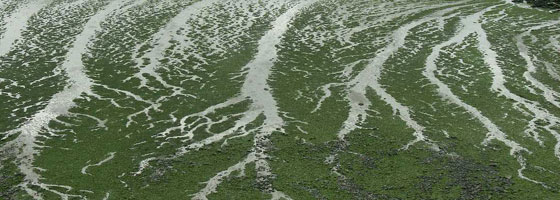Researching the Effects and Causes of Harmful Algal Blooms

The environmental impact of harmful algal blooms (HABs) is both negative and extremely pervasive. Toxins released by these highly condensed, massive algal formations commonly harm aquatic life, compromise drinking water sources, and hinder water-reliant industries such as fishing and tourism.
According to the National Oceanic and Atmospheric Association, HABs cost coastal communities in the U.S. approximately $82 million per year.
Present in both fresh and salt water bodies, the occurrence of HABs is often unpredictable and inexplicable. While the causes of HAB formation in some locations appear to be entirely natural, others seem to be induced by human activity.
Many different forms of algae can “bloom,” but HABs are predominately caused by photosynthetic organisms called cyanobacteria, or blue-green algae.
Toxins produced by HABs are, in many cases, strong enough to cause health concerns for humans. According to the Department of Health and Human Services, Centers for Disease Control and Prevention website, “Humans who drink or swim in water that contains high concentrations of cyanobacteria or cyanobacterial toxins may experience gastroenteritis, skin irritation, allergic responses, or liver damage.”
As it appears HAB occurrences are mounting across the globe, increased resources are being dedicated to understanding what causes their formation, and what can be done to limit their negative effects.
Some of the resources for HAB research come by way of federal appropriations under the Algal Bloom and Hypoxia Research and Control Act of 1998 (HABHRCA, Public Law 108-456), which was renewed by the Harmful Algal Bloom and Hypoxia Amendments Act of 2004 (HABHRCA 2004, Public Law 105-383).
The National Centers for Coastal Ocean Science is leading NOAA’s efforts to research HABs with hopes of understanding how their detrimental impact can be lessened.
NCCOS’s Ecology and Oceanography of Harmful Algal Blooms Research Program is developing new methods to detect HABs and the toxins they produce, to help “understand HAB dynamics, to develop HAB forecasts, and to predict and reduce impacts on people and ecosystems,” according to the NOAA website.
Researchers from the University of Southampton, Southampton Oceanography Centre, are also conducting HAB research. The Oceanography Centre’s Dr. Duncan Purdie and his team of researchers have taken real-time water quality measurements from the Fleet Lagoon in Dorset, England.
Using a multi-parameter sonde, which was submerged in the lagoon for three weeks, to collect water temperature, salinity, pH, dissolved oxygen, chlorophyll turbidity, and depth data, Purdie’s team is able to compare that data with tidal and meteorological information to help determine conditions conducive to HAB formation.
“Temperature and salinity data fit with the spring-neap tide pattern, and that pH and percent dissolved oxygen saturation data show large diel changes reflecting day-time production of dissolved oxygen and nightly removal by respiration,” Dr. Purdie said. “Similarly, pH increased during the day due to CO2 uptake and decreases at night due to CO release.”
With the use of the water quality sonde, the Southampton Oceanography center continues to make headway in understanding water quality conditions within HAB affected waters.
While the causes of HAB formation remain ultimately unknown, researchers around the world are working hard to help understand their causes, predict their occurrences, and limit their harmful environmental, health, and economic impacts.
Harmful Algal Blooms: HAB Impacts are Far Reaching [National Oceanic and Atmospheric Administration]
Investigating the Ocean Algae Blooms [National Environmental, Data, and Information Service]
Harmful Algal Blooms, [LakeScientist.com]
About Harmful Algal Blooms [U.S. Department of Health and Human Services Centers for Disease Control and Prevention]




0 comments